Introduction
Navigating the vast and unpredictable seas requires not only skill and precision but also a steadfast commitment to safety protocols. In the world of cargo shipping, where the margin for error is slim, the importance of adhering to top safety measures cannot be overstated. This article delves into the essential safety protocols that cargo ships must follow to avoid shipwrecks and ensure the safety of their crew, cargo, and the marine environment.
Understanding the Critical Nature of Safety
Safety on cargo ships is paramount. It is not just about avoiding accidents but also about ensuring the well-being of the crew, safeguarding the cargo, and protecting the marine environment from potential hazards. The dire consequences of neglecting safety measures underscore the importance of comprehensive safety protocols.
Regular Inspections and Maintenance
Ensuring Hull’s Strength and Durability
The integrity of the ship’s hull is fundamental to its overall safety. Regular inspections and maintenance are crucial to detect and repair any damage or weakness that might compromise the ship’s structural integrity.
Maintaining Engine and Operational Equipment
A cargo ship’s engine and machinery are its heart and soul. Ensuring these are in top condition through regular checks and maintenance prevents breakdowns at sea, which can lead to catastrophic outcomes.
Upgrading and Testing Navigation Tools
Navigation systems are critical for the safe passage of cargo ships. Keeping these systems updated and regularly tested is essential for avoiding navigational errors that could lead to shipwrecks.
The Role of Crew Training in Emergency Preparedness
Conducting Regular Emergency Scenarios
Emergency drills are a cornerstone of crew training. Regularly simulating scenarios like fire, man-overboard, or hull breach prepares the crew to respond effectively in real emergencies.
Proficiency in Using Safety Equipment
Training the crew in the proper use of safety equipment ensures that in the event of an emergency, every member can act swiftly and efficiently, minimizing risks to human life and the ship.
Navigating Through Adverse Weather Conditions
Advanced weather monitoring tools and planning are vital for navigating through storms or high seas. Timely and accurate weather information allows for route adjustments to avoid hazardous conditions.
Ensuring Effective Onboard and Shore Communication
Robust communication protocols ensure that the ship’s crew and shore-based operations are always in sync, especially during emergencies. This coordination is critical for quick response and support.
Adhering to Environmental Regulations and Practices
Cargo ships must follow environmental regulations to minimize their impact on the marine ecosystem. This includes proper waste management, avoiding pollution, and compliance with international maritime conservation laws.
Safe Cargo Loading and Securing Techniques
Proper cargo handling and stowage are essential to maintain the ship’s balance and stability. Overloading or improper securing of cargo can lead to capsizing or other serious accidents.
Protecting Navigation and Communication Systems
In an era where cybersecurity threats are on the rise, protecting a ship’s navigation and communication systems from cyber attacks is crucial for maintaining operational integrity and safety.
Conclusion
Reinforcing safety protocols is not just a regulatory requirement but a moral imperative for those navigating cargo ships across the globe. By adhering to these top safety measures, we can ensure the safety of the crew, the cargo, and the marine environment, thereby confidently navigating the seas.
FAQ
- What is the most common cause of cargo ship accidents?
- How often should safety drills be conducted on cargo ships?
- What role does technology play in enhancing ship safety?
- How can cargo ships minimize their environmental impact?
- What measures can be taken to improve cybersecurity on cargo ships?

